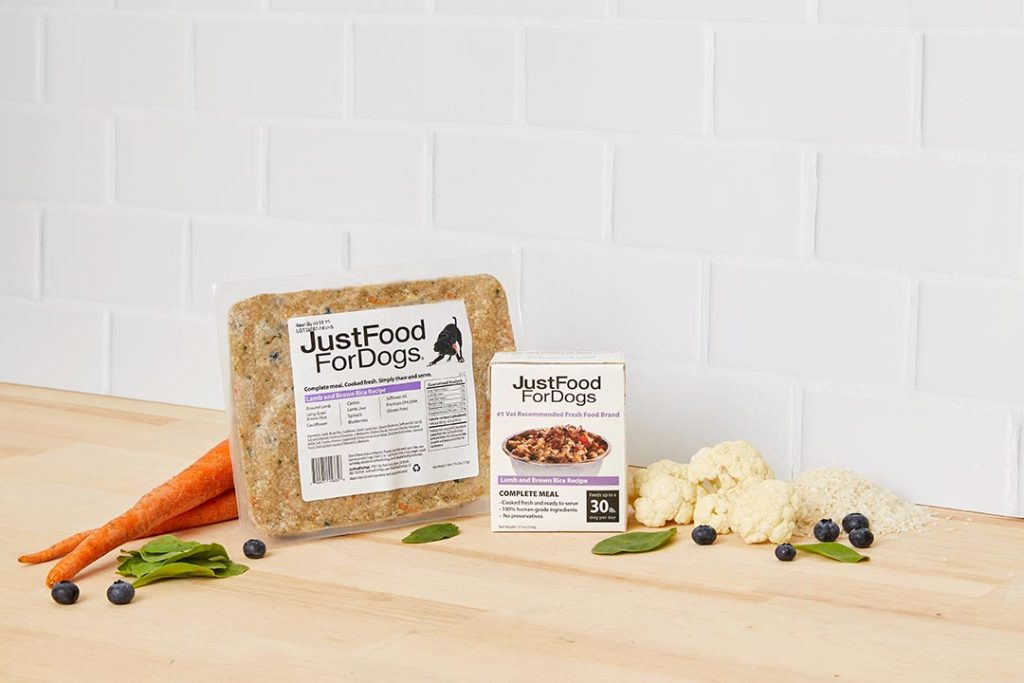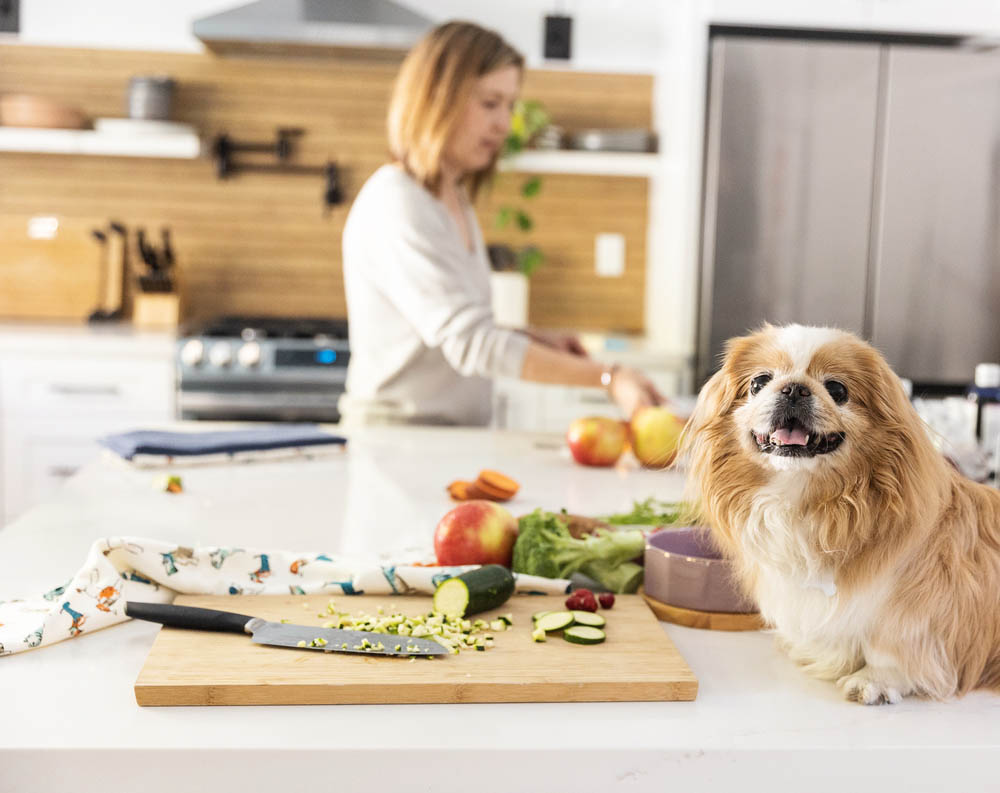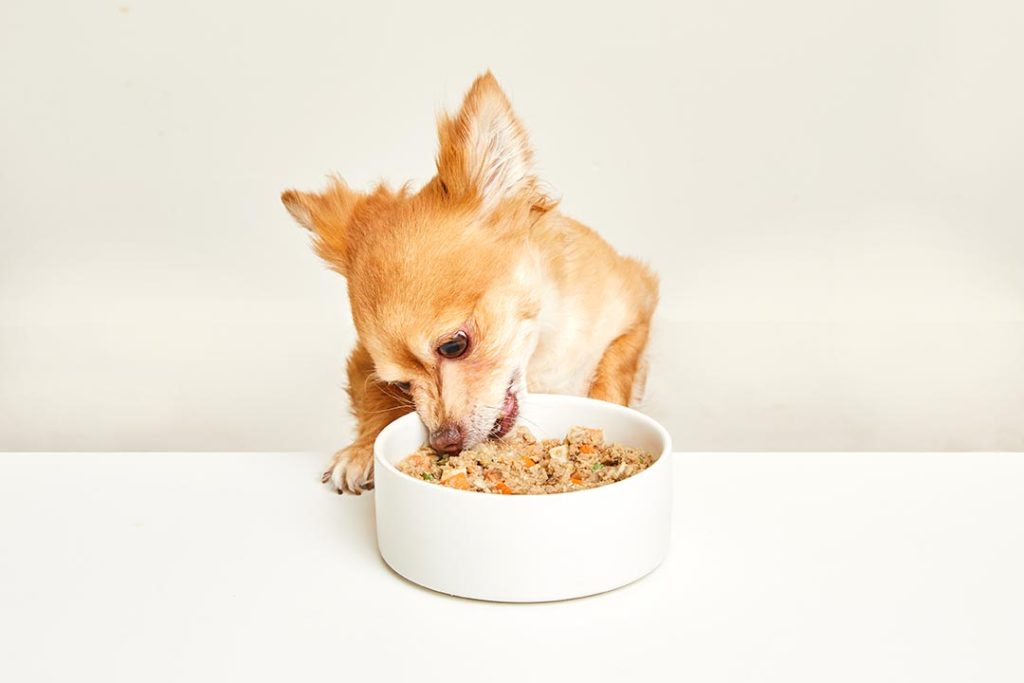We all love choices, but wow, the dog food selection can be overwhelming! There seems to be no end to dry kibble brands, canned food, raw or fresh food, dog food for a specific life stage, or breed-specific food. Dog food labels seem to be a puzzle all in itself.
No wonder pet parents often ask veterinarians, “What should I feed my dog?”
You know you want a high-quality food that meets your dog’s nutritional needs and helps your floof thrive. But reading dog food labels can feel like trying to understand a foreign language.
Here’s how you can make sense of the dog food label.
What Dog Food Labels Tell You

Pet owners probably realize a dog food label offers a snapshot of the food’s nutritional profile. The label is more than just a list of food ingredients. You’ll see carbohydrates, protein, fat breakdown, and calorie content, along with the Guaranteed Analysis and nutritional requirements.
Across the front of the package is the product name describing what’s inside the package.
For example, “chicken and white rice” or “beef and sweet potatoes.” But here’s an important point: the product name is more than a descriptor. It’s a clue to how much chicken or beef is in the package.
You might see “chicken for dogs,” “chicken dinner for dogs,” or “dog food with chicken.” If you don’t know better, you’d think they mean the same thing, but they don’t. Not in the pet food land. Instead, these distinctions represent the amount of chicken (or other ingredient) in the dog food.
If you’ve heard of rules like the 95% rule or the 25% rule, that references how much of the product name is in the dog food. These rules come from The Association of American Feed Control Officials (AAFCO), which oversees pet food guidelines.
The 95% Rule
Here’s how it works.
- The 95% rule means the dog food must have a minimum of 95% chicken. A product that lists “Chicken for dogs” on the label has the highest protein count. The AAFCO says the last 5% can be other ingredients, vitamins, and minerals.
- The 25% rule means the dog food must have a minimum of 25% chicken. Look for “Chicken dinner for dogs” or any dog food with the words “dinner,” “entree,” or “platter.”
- Product names that use “with” have a minimum amount of protein. Think, “dog food with chicken.” The AAFCO says such a product only needs 3% of chicken, and the other ingredients can be byproducts, fish or meat meal, and artificial preservatives.
At the lowest end of the nutrition scale would be the “flavored” products labeled chicken “flavored” or beef “flavored.
That product name tells you a lot! You’ll never look at them the same way. Once you understand the significance of the product name, you can move quickly to the rest of the dog food label.
Assess the Food Ingredients List

You see a list of food ingredients when reading a dog food label. The first thing to know about the ingredients list is the ingredients are in descending order.
This means the first ingredient is always the most important one. In high-quality pet food, you’ll see named protein as the first or second ingredient. Water might be the first ingredient, especially in canned food, since liquid is heavy.
As you go down the list, the ingredients come in smaller and smaller increments.
Some dog foods include meal, which is ground and powdered ingredients. Meal can add more protein to a pet food, but it’s of higher quality when it’s a named ingredient. For example, chicken meal is higher quality than meat meal.
Meal is made by cooking down chicken, meat, or fish at a high heat to remove moisture and fat. Then it’s dried and ground. It makes for a high-protein ingredient.
Some dog food brand names include byproducts in their food. Technically, these are secondary products like the liver, kidneys, and other materials. It’s all edible, and dogs seem to love them. Meat byproducts like organ meats are nutritious and good protein sources, especially when they are USDA-approved/human-grade.
Of course, you might choose to feed your dog a nutritious balance of whole human foods designed for dogs. Then, it’s pretty simple to know what your dog’s eating.
Let’s move on to the Nutritional Adequacy Statement.
Nutritional Adequacy Statement
The Nutritional Adequacy Statement is a label on the packaging. They provide nutrient profiles to outline the minimum requirements for dog food based on specific life stages such as puppyhood, pregnancy, or adult maintenance.
When you see a brand name pet food that claims to be a “complete and balanced diet,” that means the food has met the AFFCO standards for the minimum nutritional requirements for adult maintenance. Here are some questions you can ask about your pet food.
While many pet foods are labeled for different life stages, the Food and Drug Administration (FDA) says there’s little evidence senior dogs need special food. This means “senior” dog food meets the nutritional requirements for adult maintenance. It is a good idea to keep your senior dog a healthy weight and not let them loll about munching on snacks and piling on the pounds.
Nutrient profiles display the minimum and maximum nutrients required for each life stage.
What about the Guaranteed Analysis?
What’s Guaranteed Analysis?

The Guaranteed Analysis provides information on the nutritional value of the food.
For example, it lists the minimum and maximum amounts of protein, fiber, fat, and water. You’ll see crude protein, crude fat, and crude fiber. “Crude” is a method of measurement like ounces. When you see crude fiber on a dog food label, a food sample is tested to know how much plant material is in the food.
A crude fat measurement means how much fat is in the food. This fat can be healthy fats like omega fatty acids and unhealthy fats.
If the pet food says it includes ingredients like omega-3 fatty acids or calcium, you’ll see these listed on the Guaranteed Analysis. Then, you can look at the food ingredients list to see where the omega-3 fatty acids appear in the list. If they’re at the bottom, there’s not a lot of fatty acids.
Feeding Directions
The feeding instructions might be the simplest part of the dog food label as it tells you how much to feed based on your pup’s weight. Think of feeding guidelines as just that, rather than rules, because every dog is an individual with different activity levels.
Each pet food label includes the calorie count typically expressed as kilocalories per kilogram per serving.
Always ask your veterinarian if you have questions about your dog’s activity level and nutritional requirements.
What Type of Food Does Your Dog Need to Feel Its Best?

Some pet food companies have researchers on staff who study pet food formulations and pet needs. Some of these researchers uncovered concerns about certain pet foods. For example, this study found that 75% of dry food contains elements of mycotoxin, which is a toxic form of mold.
Concerned pet parents can look into pet food manufacturers to better understand the quality of their pet food products and recognize these ten dog food myths.
If you want to feed your pup high-quality dog food, you could choose a healthy food made from fresh human foods packed with essential nutrients. Take our chicken and white rice recipe. It’s made of human-grade chicken, white rice, spinach, carrots, apples, chicken gizzards, and chicken liver.
Wrap Up
Nutrition plays a big part in pet health, and it’s worth learning to read a dog food product label. By now, you’re starting to recognize the nutritional profiles of high-quality pet food.
If you understand the significance of the product name and the elements of the dog food label, you’re in a better position to recognize high-quality pet food benefits on pet health. Now, it’s simpler to choose a balanced dog food packed with essential nutrients for every life stage to keep your pet healthy.
